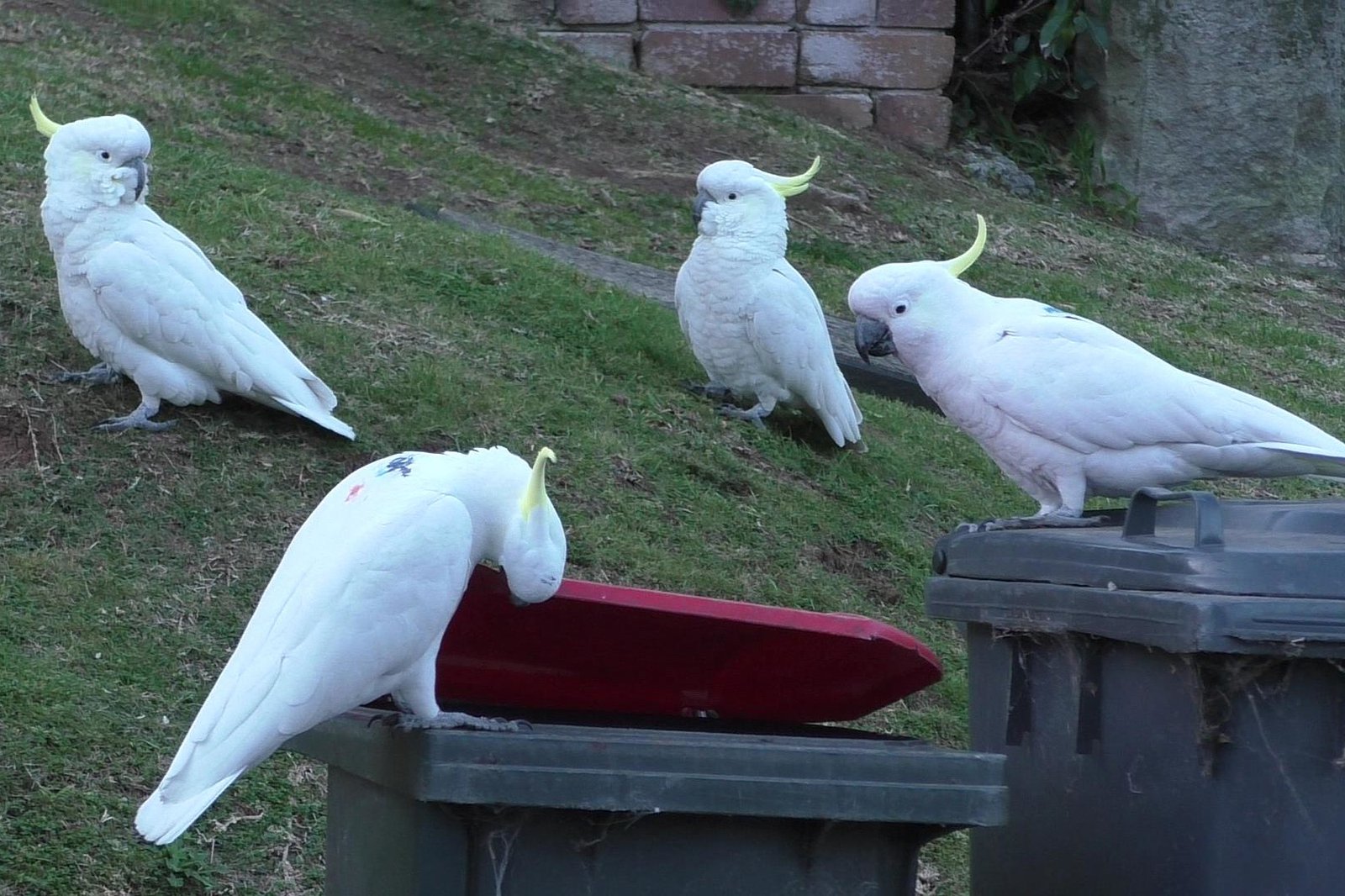Contact-tracing of Cockatoos reveals spread of foraging culture
It may seem as though the action of a cockatoo flipping a bin-lid is a simple one – but world-first research by a team including Australian Museum Research Institute Ornithology expert Dr Richard Major has revealed that this behaviour is far more significant than first thought.
If I had a cracker for every question I received about cockies behaving badly, you’d be calling me ‘Polly’. And after years of fruitless war on my local citrus pickers, new behavioural research provides a possible window to freedom.
What started as an interesting observation of bin-opening has resulted in a significant advance in our understanding of animal learning. Video analysis and intensive fieldwork on 500 colour-marked cockatoos, in combination with a community survey, demonstrated that mastering the wheelie-bin puzzle is not something that clever cockies just work out for themselves. Instead, sulphur-crested cockatoos are copy-cats and after one individual solves the lid-flip puzzle, other birds in its social network imitate the new foraging innovation.

A sulphur-crested cockatoo opening the lid of a household waste bin.
Image: Barbara Klump© Barbara Klump

A color-marked sulphur-crested cockatoo lifting the lid of a household bin while several others watch it. The colored dots on the back allow researchers to identify individuals and disappear with the next molt.
Image: Barbara Klump© Barbara Klump
What started out just south of Sydney spread quickly – within two years, bin-flipping had gone viral across 44 geographically-linked suburbs. Some birds modified the technique, perhaps walking the lid up the left side of the bin rather than the right, or holding the half-open bin with their foot, not their beak. These subtle differences in the behaviour were the key to contact-tracing, showing how geographically-localised variants arise in the cockatoo community.
Sulphur-crested cockatoos opening lids of household bins to get food out. A bird opens the lid by grabbing it on the rim, holding it with the bill and then walking along the left side of the bin pushing the lid until it flips over. A color-marked Sulphur-crested cockatoo tryies unsuccessfully to open the lid a couple of times, then grabs the lid with its bill and left foot, holds it with its bill and walks along the right side of the bin pushing the lid until it flips over. Two further color-marked birds join the first bird to also get some food out of the bin. Video: Dr Barbara Klump
While the behaviour seems largely to be learnt, more than one cockatoo has solved the puzzle. A later, and independent innovator on the northern beaches of Sydney started a similar bin-opening cluster. And although it looks to the casual observer in these areas as if all cockatoos are bin-ravaging villains, colour-marking of individuals showed that fewer than ten percent of birds learn the art, with most swooping into the open bin after the pioneers do the tricky bit (see video). As this video shows, cockatoos also have to stay on the learning curve, to cope with the wild cards that people deal them.
Sulphur-crested cockatoos filmed eating out of a bin, showing problem solving capabilities. Video: Dr Richard Major.
And this is where you can help, by participating in the 2021 cockatoo bin-opening survey and reporting if you have, and if you have not, observed this behaviour in your suburb. We are also continuing to research urban bird behaviour and value your reports of birds, nests, marked individuals (e.g. wing-tags), and behaviours including bin-opening, using the Big City Birds app or website.
So how does this help the backyard battler save their cedar window frames, flyscreens, solar-heaters or citrus crops? Be alert, and a little bit alarmed – lock it down immediately! Wave and shout the first time you observe bad behaviour, while you only have one challenger to contend with. Don’t give the flock the opportunity to share it with their close contacts, because we know they will - and you might be saving your neighbours as well as yourself!
Richard Major, Ornithology, Australian Museum Research Institute.
Barbara Klump, Lucy M. Aplin, Sonja Wild, and Jana Hörsch, Cognitive and Cultural Ecology Research Group, Max Planck Institute of Animal Behavior.
John Martin, Taronga Institute of Science and Learning, Taronga Conservation Society Australia.
Read more here:
Barbara C. Klump, John M. Martin, Sonja Wild, Jana K. Hörsch, Richard E. Major and Lucy M. Aplin. Innovation and geographic spread of a complex foraging culture in an urban parrot. Science: 23 July, 2021. https://science.sciencemag.org/content/373/6553/456












